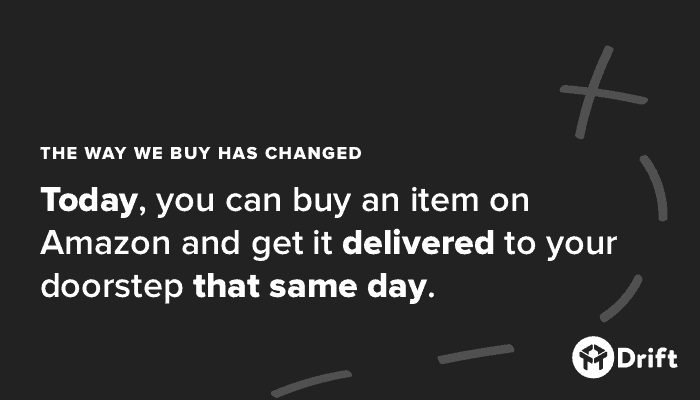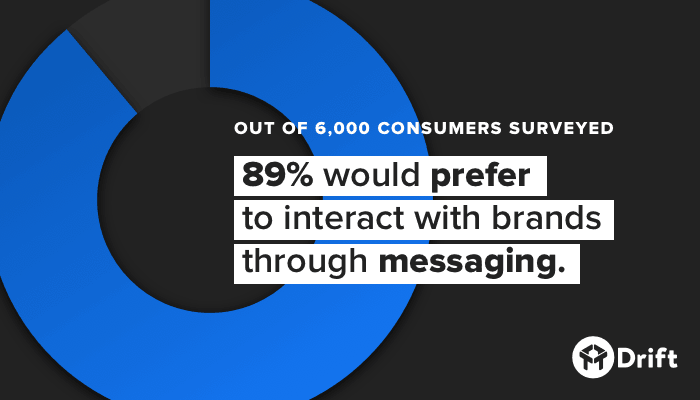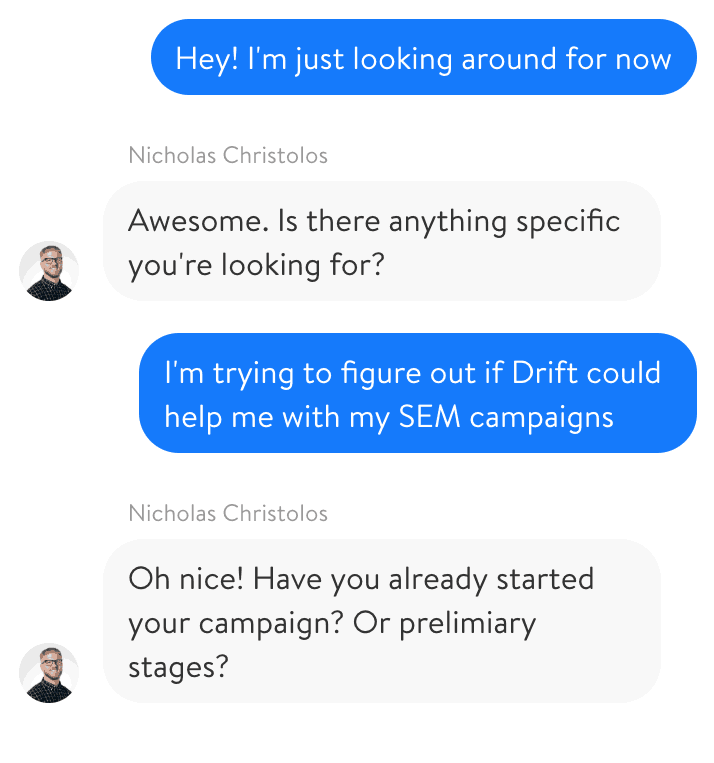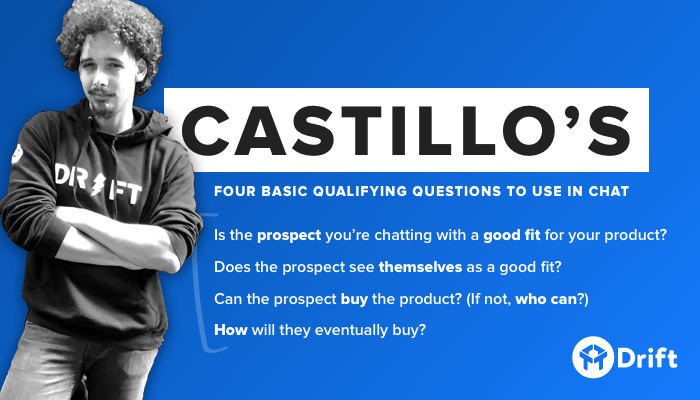
People are tired of being sold to. They’re immune to emails, turned off by the hard sell, and can spot a sales pitch a thousand miles away. These days, buyers have more information and power than ever before, and they’re not just using that power to buy products — they’re using it to buy experiences.
Twenty years ago, you might order something over the phone and wait weeks for it to arrive in the mail. Today, you can buy that same item on Amazon and get it delivered to your doorstep in a day. Emboldened by these innovations in the consumer world — lead by companies like Amazon, Zappos, Apple and others — buyers don’t have patience for the old way of buying.
Scores of consumer companies have embraced this reality, and created personalized shopping experiences that keep buyers coming back for more. And while B2B companies have used technology to optimize the back-office, they’ve failed to apply it to building outstanding customer-facing experiences.
The evidence:
- Many companies still make B2B buyers fill out forms and jump through hoops just to talk to a sales rep. This compromises lead velocity and introduces massive delays into the sales process right from the start.
- Even though B2B companies will spend $4.6 billion on ads that direct people to their website, 58% won’t engage those prospects at all when they get there.
- While chat and real-time messaging tools make it easy to engage leads, 85% of B2B companies surveyed don’t have the tools to start real-time conversations with prospects on their site.
Instead, most B2B buyers are forced into a painful sales process that bears no resemblance to the shopping experiences they’re having elsewhere in their lives.
And now, those buyers are opting out.
“It’s not as though you have a B2C consumer experience that blows you away on Amazon, or Nordstrom, or Sephora, or Charles Schwab–or wherever you’re going to go–and then, all of the sudden, go to work and say, ‘Well, now I expect a much worse customer experience, and I’m happy with that,” explains Andy Hoar, a former analyst at Forrester.

So, how can B2B companies right the ship and build a more modern buying experience?
Rather than rely on old school B2B sales playbooks, businesses must meet buyers where they are. And, increasingly, that’s through real-time messaging or chat.
In fact, in a recent global study of more than 6,000 consumers revealed that 89% of buyers would prefer to interact with brands through messaging — not endless forms, email campaigns and cold calls.
What’s more, those who have seen success with selling through chat have realized tangible return on investment:
- Sales enablement platform SalesRabbit doubled their qualified leads and increased demos booked by 40% by adding both a chatbot and real-time messaging to their site
- MongoDB increased sales opportunities by 170% and scaled sales conversations just by adding intelligent chat to their site
- Marketing agency Six and Flow cut the length of their sales cycle by 33% with the help of real-time messaging

But if so many businesses are seeing the ROI of real-time messaging and chat, why aren’t more companies adopting it?
When our Drift Partners visited the Boston office a couple weeks back, I decided to ask them this exact question.
“Before you get started selling in chat, it seems like it’s going to be more complicated than it really is,” explained one Partner.
“I think people just need the basics. And while you have a ton of content on the bigger picture parts of conversational sales and marketing, people need the tactical stuff to get started,” explained another.
That made total sense.
??
So today, I’m fixing that.
For the next few minutes, I’m going to break down how you and your sales team can perfect the art of conversation in chat, and why specific techniques matter so much.
I’ll be honest — there’s nothing complicated about any of this. But sometimes it helps to put all the information about something in one place — then you can see where you need to improve, use it as a blueprint for building a conversational sales org, or just get on the same page with your team.
Oh, and I’ve also got inside tips from sales execs both in and outside of Drift, as well as advice from Drift’s very own Conversational Sales team.
The 5 Things You Need To Do To Have A Successful Sales Conversation in Chat
Human speech as a form of communication has been around for millions of years. But for the bulk of that time, non-verbal cues–also known as body language–have helped humans better understand one another.
So, in a world that increasingly relies on messaging to communicate, how do we optimize for understanding and outcomes in sales chat?
Let’s unpack this.
#1 – Start a real conversation. ??
It used to be that when a prospect landed on your website, you’d do everything in your power to get them to fill out a form and download some content. But these days, forms–at best–do nothing to capitalize on the high intent of a visitor to your site, and at worst serve as a dead-end for leads who’d rather not fork over their information in exchange for endless sales calls.
Fortunately, today, we’ve got a much better way to make the most of the traffic on our website, and it starts with a conversation.
Once you’ve implemented real-time messaging on your website with Drift, you have the ability to chat with site visitors using a bot or a human. I recommend using both in order to ensure that there’s always someone around to talk to prospects, answer questions, or book meetings with sales reps.
But, regardless of whether you staff with a bot, a sales rep, or both, a sale won’t happen without first having a conversation, so say hello to your visitors.

If you’ve got a bot handling some of your initial conversations or providing coverage during out-of-office hours, we’ve got you covered with some basic scripts you can add to Drift to route leads to the right reps and get their questions answered.
But if one of your sales reps is on chat duty, lessons from the front-lines of chat can help you make the most of conversations with your prospects.
As a seasoned sales leader, Robert Gibbons, VP of Sales at Ipswitch, has trained teams around the world in the art of conversation. After implementing real-time messaging on his company’s website, he then had to evolve his approach for teaching his sales reps how to sell in chat.
What did Gibbons learn? It’s imperative to reduce what he calls “relationship tension” at the start of every chat.
“People don’t want to feel ‘sold’, they want to feel like you’re an ally, a resource — so you want to start a conversation by asking for permission to ask that very first question that’ll kick things off,” he says.
Gibbons goes on to explain:
“The simplest way to open a conversation on Drift would be, Would it be alright if I asked you a question? When the prospect says yes, I’ve accomplished two things: I’ve reduced relationship tension and I’ve got permission to move forward.”
For sales reps on the front lines of selling via chat, diffusing that tension is key to getting prospects to view you as an ally, and not someone who simply wants to make a sale. In this way, starting a conversation is the first chance you have at building rapport with a prospect.
What else helps in starting a conversation?
“Use your personality and sense of humor to build rapport with people and take an entirely consultative approach. Whether people are on your site, chatting in, or you’re proactively engaging them, it’s for a reason. Sales reps can use conversations to find out what that reason is,” explains Steve Palombo, a Conversational Sales Advisor at Drift.
Key Takeaways:
- Differentiate between bot and sales rep talk tracks
- Be real and authentic
- Build rapport with a consultative approach
#2 – Connect with your prospects. ?
Sales conversations need the right fuel to drive business outcomes. But conversations have to be on the prospect’s terms–otherwise, you run the risk of pushing your prospect away.
“I always say chat is a lot like fishing: you’ve got to know when to give and know when to pull,” explains Nick Christolos, Conversational Sales Advisor at Drift.

As B2B buyers grow more empowered throughout the sales process, pushing products or services on customers isn’t just unpleasant–it’s ineffective. The purpose of chat isn’t to drive a hard sell, it’s to see if your prospects are the right fit for your product, and get them to the next stage of the sales process. If reps want to draw out the information needed to qualify a prospect through chat, they must remember that it’s not an interrogation, but a conversation.
“I always try to make a personal connection with a prospect. If they’re from a part of the country I’ve visited, or plan to visit, I call it out during the conversation. And if you know anything about sports, you can always build rapport just by bringing up the final score of a game, or something along those lines,” explains Alex Hanbury, Conversational Sales Advisor at Drift.
Key Takeaways:
- Don’t make your sales conversation feel like an interrogation
- Forge a personal connection with your prospect
- Show your personality
#3 – Listen and qualify.??
“The art of conversation is the art of hearing as well as of being heard.” ― William Hazlitt
Want to master the art of conversation? Stop talking so much.
“Conversations start with listening attentively. As sales reps, we must show genuine interest in our customers’ businesses. Effectively, we must care about our customer’s customer,” says Michael Castillo, a Conversational Sales Team Lead at Drift.
This highlights how important it is for sales teams to both listen well and show they’re listening in order to build trust with a prospect, and ultimately, qualify them.
So, how do you do that in a conversation?
When training his sales reps on how to sell in chat, Gibbons encourages sales reps to leverage the power of empathy statements to confirm what they’re hearing from prospects, then probe deeper to make sure they’re the right fit for your product.
“Salespeople require good listening skills, but good listening skills alone do not guarantee sales. Successful salespeople listen to what customers say, analyze what they said, and integrate the newly acquired information within the context of the customers’ world. Buying obstacles raised by customers don’t have to make sense in the salesperson’s world; it only has to make sense in the customers’ world… Empathic Statements allow salespeople to quickly build rapport and to analyze and overcome buying obstacles from the customer’s perspective.”- Jack Schafer, Ph.D.
Here are 10 great examples of empathy statements:
- “So, if I’m hearing you correctly, you’re having {this problem} while trying to achieve {this outcome}?”
- “Thanks for letting me have some of your time today, {name},”
- “Thanks for telling me more about {the problem/challenge they’re experiencing}.”
- “How are we doing so far? Am I answering all of your questions?”
- “Can I make a suggestion?”
- “I’d love to dig into this a bit more. Mind if I ask a few more questions?”
- “I can definitely answer that/those questions for you, but please stop me at any time.”
- “Is it ok if we review everything we’ve covered so far?”
- “How is {your current solution} working for you right now?”
- “Would you mind telling me more about {pain point or interesting challenge}?”
You can use empathy statements throughout sales chat conversations, and you’ll probably need to, advises Gibbons. That’s because your prospect has the power to say “no” to a question at any point in time.
What do you do when that happens?
“If you get a hard ‘no’, you’ve got to apologize, and course-correct using a different empathy statement. Let the prospect know you recognize that boundary, and then ask for permission to ask a different question,” Gibbons advises.
If a prospect has given you permission to gather more information, sales reps should then do the work of connecting the information they’re hearing with their specific qualifying criteria. Although that criteria will vary based on your target customer profile, Castillo says there’s no need to capture every bit of data to qualify a prospect in chat.
“I use four basic qualifying questions in sales conversations at Drift–is the prospect a good fit for our product? Do they see themselves as a good fit? Can they buy it? How will they eventually buy?” he explains.

Another way to qualify a prospect?
Gibbons likes to use the “three whys”, a popular decision-making framework that can also help guide a sales conversation. Using the three whys allows you to make the most of your time with a prospect on chat, and allows you to get a deeper understanding of the problems your prospect is hoping to potentially solve with your product.
Why anything?
What are things like now? What does the picture look like for the person you’re speaking with?
Why now?
What do you want it to look like? Was there a compelling event? Find out what’s personally important to the people you’re speaking with?
Why [your product]?
What will a solution help your prospect accomplish? How will pain points be addressed through a new tool or platform?
By deploying empathy statements strategically in your sales conversation, you can demonstrate that you’re listening to prospects and build rapport rapidly via chat. This will uncover more of the pain they’re experiencing, and how your product can help.
Key Takeaways:
- Leverage frameworks for guiding conversation
- Show your listening with empathy statements
- Build rapport by taking a genuine interest in a prospect’s business
#4 – Show the value of your solution.✅
So you’ve started a conversation in chat, connected with prospects, and showed them you understand where they’re coming from. Time to book the next meeting or demo, right?
Wrong.
Before you can get someone to the next stage of the sales process, you’ve got to be sure you’ve demonstrated the value of what you’re selling them. And your solution is only going to be valuable if you describe it in ways that speak directly to their business challenges, and in measurable ways.
“If you’re in chat and a prospect is engaged, ask for some of their funnel metrics like leads, opportunities, close rate, average sale price. If you know where people are coming from, you can show the value of your solution by pointing out how you can move those metrics,” explains Robert Boerrigter, a Conversational Sales Advisor at Drift.
Key Takeaways:
- Ask prospects for key metrics to benchmark where they’re at today
- Then provide information about how your product can improve those key metrics
- Never end a chat before demonstrating the value your product can provide
#5 – Book a meeting.?
The purpose of a sales conversation in chat is to drive towards booking a meeting, or best case scenario, a sale. But asking to take your relationship with a prospect to the next level can be a bit tricky.
That’s where empathy statements can help you avoid breaking the trust you’ve earned, and in driving towards a specific outcome.
“At this point in the conversation, it’s important to check-in with the prospect about where you’re at, and see if they’re ready to book a meeting, or even buy,” states Rob Perez, Director of Sales at Drift.
Use phrases that touch on what you’ve covered in your conversation so far, while asking for permission to talk about what might happen next. Some good examples:
- “Would it be accurate to say that, based on what we’ve talked about, you’d be able to drive [this outcome] using [product]?”
- “It sounds like we should continue this conversation to talk in detail about [goal 1], [goal 2] and how [product] would help.”
- “If I’m hearing you correctly, it looks like [product] could be useful to your business in hitting [goal 1], [goal 2] — is that fair to say?”
And there’s no rule about having to close people in chat. If you want to make it more personal, Perez recommends dropping a Zoom link into the chat and having your prospect jump on a fast video call.
“By starting the conversation over chat and then connecting with a prospect face to face via video, you build a stronger connection with your prospect,” explains Perez.
Key Takeaways:
- Don’t leave a chat open-ended — drive towards an outcome
- Use empathy statements to drive to the next stage in the sales process
- Use video to personalize the final ask
The New B2B Sales Process Is All About Pull, Not Push
Today’s buyer doesn’t want to be sold.
They don’t want to wait to talk to a sales rep, or suffer the pitfalls of today’s endless B2B sales process.
What they want is an experience that feels helpful, authentic, and impactful for their business. And increasingly, this experience begins with real-time messaging or chat.
The faster that B2B companies deliver an outstanding experience through this channel, the greater success they’ll see in converting current target buyers, and the B2B buyers of the future.



